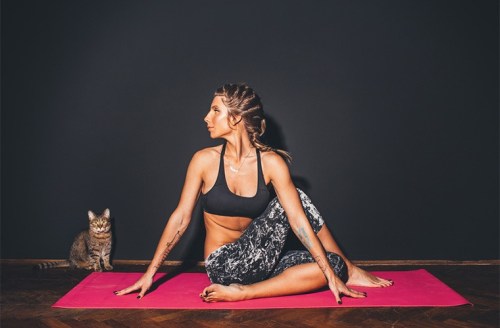Our editors independently select these products. Making a purchase through our links may earn Well+Good a commission
Yoga teachers are living the dream, but are they making a living?
Most yoga teachers are living the dream—they love their jobs. (And enjoy excellent karma.) But are they making a living? In many cases, the answer is no.

Most yoga teachers love their jobs (and the excellent karma), but are they making a living? According to Ava Taylor of YAMA Talent, the first ever yoga talent agency, the answer is no—if teaching is their only form of income.
“We do a lot of business consulting at YAMA and it’s because folks are accidental entrepreneurs,” she says. “You don’t graduate from yoga teacher training, get your certificate from the Yoga Alliance, apply for a job, and guaranteed a salary of $40,000. You have to piece it together.”
Taylor’s stable of super-established and highly credentialed yogis earn anywhere from $40K to $400K. While the salary range is huge, most yoga teachers in New York can expect to make $35K or $40K, Taylor says. “Even if you become a really popular instructor, with 50 people in your class regularly.”
So how exactly do yoga teachers fill their bank account?
Building their brand online—from teaching on streaming platforms to growing a social following. “The opportunity to broadcast yourself has helped people earn more money than ever before,” Taylor says.
For example, “back in 2011, there were only one or two companies offering online yoga content with a paywall. Now, my firm alone represents 10 to 12 that do and it can be very lucrative—money teachers have never seen before,” she adds.

Taylor points out that workshops, teacher training, and private sessions are all offered online now. “The way I look at it, a yoga teacher’s portfolio basically has a duplicate because it can happen in person and online,” she says. “It’s opened up the sort of salary that’s possible.”
Which brings up something else that’s hard to ignore: there are more (digitally born) yoga superstars than ever. And while it isn’t easy to build a social following, Taylor says it does pay off—big time.
There are more (digitally born) yoga superstars than ever. And while it isn’t easy to build a social following, it does pay off—big time.
“Once you have a certain number of followers, you have brand opportunities you didn’t before,” she says. Like brands looking to compensate influencers for snapping selfies with their superfood powder or fitness fashion brands looking to pay yogis for posing in their pants.
Taylor says the rise of internet yoga superstars is totally a good thing and has helped the industry as a whole. “It brings the whole industry up,” she says, adding that, like any other career, it takes time and diligence to reach that level.
But what about the rise of Classpass and boutique fitness? How has that affected things? Well, not positively, it turns out. “Classpass has really affected studio revenues across the board, which in turn has a trickle down aspect of running the business,” says Retox author and I.Am.You Studio owner Lauren Imparato. “Classpass is basically giving studios less than 50 percent a head of what they used to normally get, and that’s obviously not good.”
As a result, many studios rely on teacher trainings to generate income. “There are thousands upon thousands more yoga teachers [than in 2011] mostly because studios pump out teacher training programs as an economic engine,” says Imparato, who previously worked in finance.
Teaching classes are just one piece of the pie.
But as many studios know well, more teachers, coupled with studios getting less than half of what they used to per person if they use Classpass, and rising studio rent costs just isn’t a good equation.
Which is why it’s all about the hustle. “Teaching classes is just one piece of the pie,” Taylor says. Cultivating a strong social following to snag brand opportunities, offering online yoga content with a paywall, workshops—online and in person—and getting creative in other ways is the secret formula to success. “Everyone can diversify now, and that’s what’s really cool,” Taylor says.
Find out what the world’s oldest yoga teacher has to say about happiness. And check out why thousands of people are taking this super popular #yogachallenge…
Originally posted December 19, 2011. Updated November 22, 2016.
Sign Up for Our Daily Newsletter
Get all the latest in wellness, trends, food, fitness, beauty, and more delivered right to your inbox.
Got it, you've been added to our email list.









